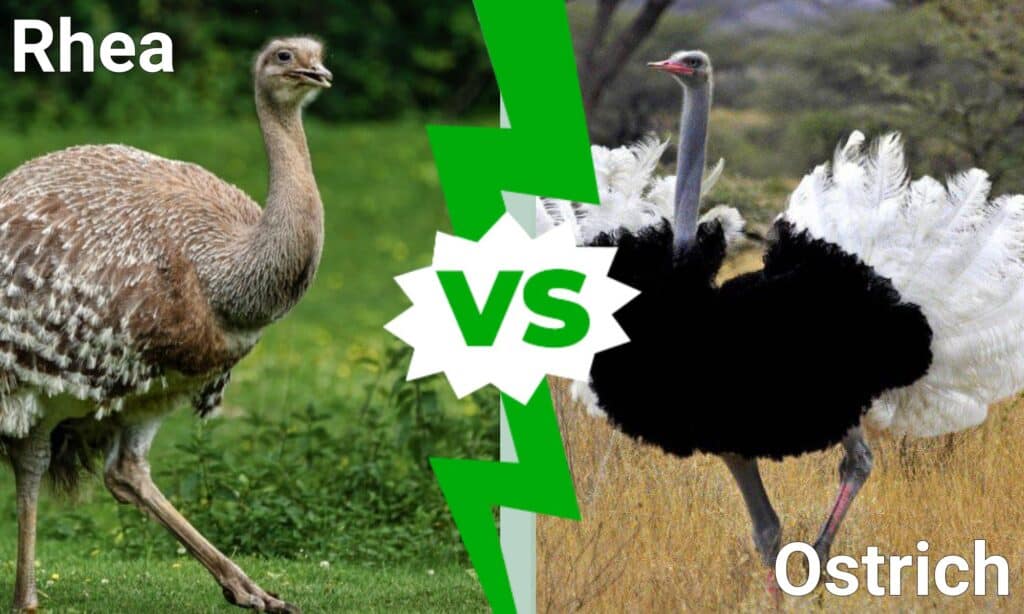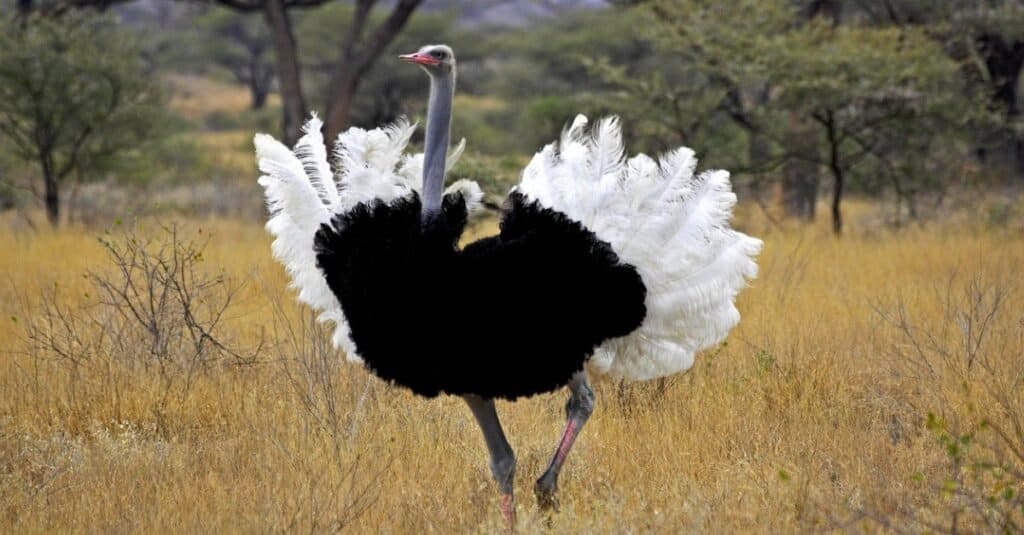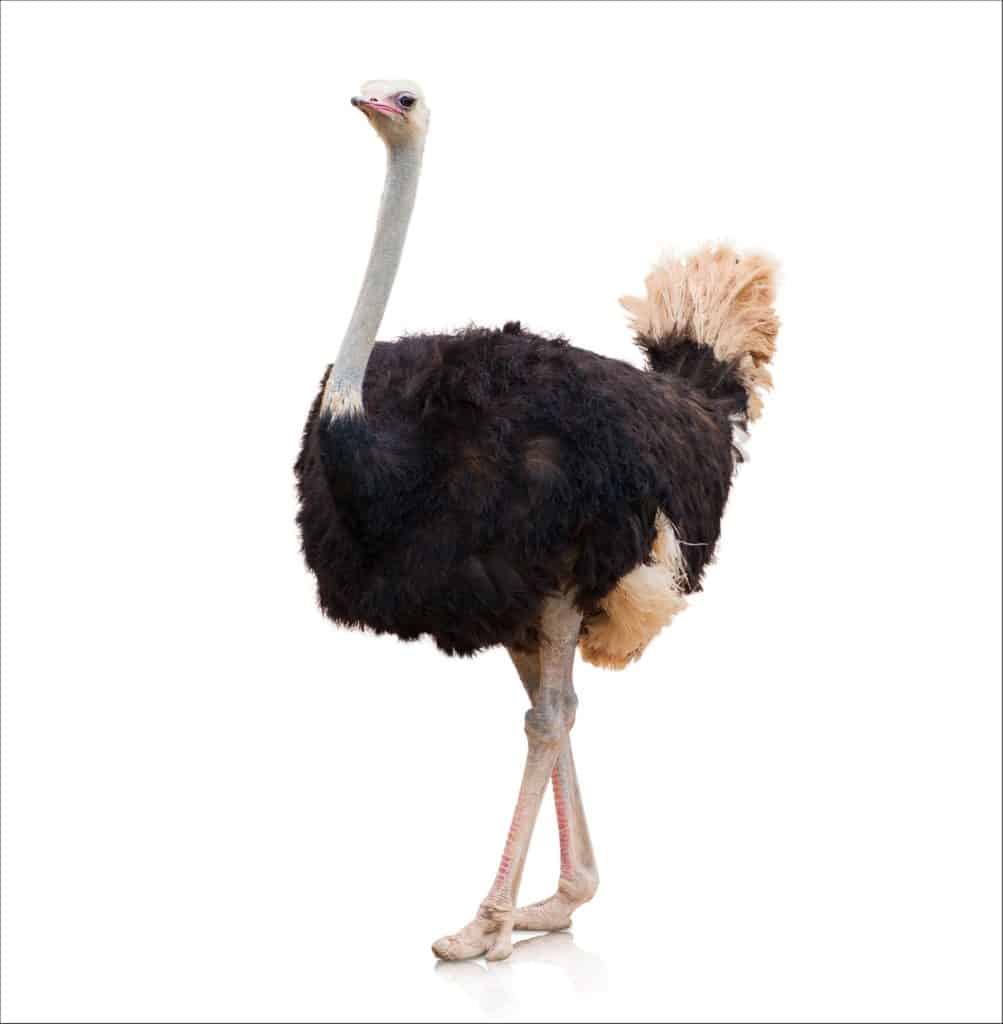In today’s post, we’ll compare the greater rhea and the ostrich, two bird species that are closely related. Both the Rhea and the Ostrich are ratite, flightless birds. A ratite is any bird with a smooth or raft-like sternum (breastbone) due to the lack of a keel to which the flying muscles might be attached. Even though both birds are flightless and look strikingly similar, there are a few key distinctions. In terms of size, rheas are smaller than ostriches. Also, despite their apparent likeness, these two birds come from two distinct continents! Let’s take a closer look at their differences.
Rhea vs Ostrich: A Comparison

| Key Differences | Rhea | Ostrich |
|---|---|---|
| Location | South America | Africa |
| Size | 3 – 5 feet; 33 – 66 lbs. | 9 feet; 330 lbs. |
| Looks | Smaller, 3 Toes Per Foot, Loose & Rough Feathers | Larger, 2 Toes Per Foot, Loose & Silky Feathers |
| Speed | 40 MPH | 43 MPH |
| Temperament | Non-Aggressive, Competitive For Females | Territorial, Can Become Aggressive |
| Domestication | Possible With Proper Care | Profitable in Commercial Farming |
| Life Expectancy | Up to 13 Years | 30 – 70 Years |
| Endangered | Near Threatened in Native Ranges | Least Concern: But Numbers Are Decreasing |
Key Differences between Rhea and Ostrich

The Greater Rhea is one of the largest tropical birds in the world and is the largest in South America.
©Ondrej Prosicky/Shutterstock.com
The greater rhea is the largest of all South American birds! The rhea is the only member of the Order: Rheiformes, which is found only in South America. Two types of rheas are called the “Greater” and “Lesser” rheas. This species is smaller than the bigger rhea and can only be found in Patagonia as well as the southern Andes. Together, there are eight subspecies of rhea, and active debate in the scientific community whether the Puna rhea is actually a third species.
One of the most talked-about ratite birds is the ostrich. It is part of the genus Struthio. There are four types of Ostriches: Southern, Northern, Masai, and Somali. The Southern, Northern, and Masai are each subspecies of the common ostrich while the Somali ostrich was declared a unique species in 2014. They each have different geographic ranges, however, all of them live in Africa. Africa’s largest bird is the Ostrich. In fact, it’s the biggest bird in the world!
Appearance and Basic Info

Ostriches can weigh up to 330 lbs!
©NileshShah/Shutterstock.com
Rhea vs Ostrich: Size
Ostriches can reach a height of 2.75 meters (approximately 9 feet) and have a neck that makes up more than half of their overall height. It is possible for males to reach a weight of more than 150 kilograms (330 pounds).
Rheas are significantly smaller than Ostriches, and can even be mistaken for a baby one. About 3-5 feet (0.9-1.5 meters) tall, the rhea weighs 33–66 pounds (15 and 30 kilograms).
Rhea vs Ostrich: Looks

A male ostrich, Struthio camelus, in courtship display at the Masai Mara Park in Kenya.
©iStock.com/slowmotiongli
The rhea has a long neck and long legs. Rheas have feathered heads, necks, and legs, but no tail. Rheas are flightless birds with unusually enormous wings. They have a rougher and looser plumage than Ostriches. The brownish rhea has a brown or gray upper body with creamy underparts.
Ostriches have a long neck, bare legs, and a whitish-grey underbelly. Ostrich feathers are loose, silky, and smooth. As a result, Ostriches have a “shaggy” appearance. Ostrich males have a pinkish or blue neck, whitetails and primary feathers, and black plumage in the breeding season. Females are smaller and greyish-brown, whereas juveniles are similar but darker.
Characteristics

Ostriches (Struthio Camelus) are the largest bird in the world, flightless or not!
©Krakenimages.com/Shutterstock.com
Rhea vs Ostrich: Speed
Rheas have strong legs with three toes that are suited for speed. They are unable to fly due to the absence of a breastbone that links the muscles required for flight. Despite their inability to fly, rheas can run at speeds of up to 40 miles per hour. To avoid danger, rheas use their long, muscular legs. Even though their huge wings are inefficient for flight, they are used to keep the bird balanced and change direction while it runs.
Rheas can run swiftly, but not as fast as an ostrich; in fact, the ostrich is the fastest bipedal land animal. Ostriches are made for speed despite their lack of flight. The ostrich’s powerful legs allow it to sprint up to 43 mph (70 kph) in short bursts and sustain a constant speed of 31 mph (50 kph) (50 kph). To evade predators and maintain balance while running, they utilize their wings like an airplane rudder.
Rhea vs Ostrich: Temperament
Male rheas compete for females during the breeding season, although they are not hostile towards each other or other species. Ostriches may become aggressive rather than escape in the face of danger, and they may also strike if they feel the need to protect their young or their territory.
Rhea vs Ostrich: Domestication
Rheas do not make good pets. People haven’t bred these wild creatures long enough. A special farm has been established for greater rheas, who have long been hunted for their feathers, meat, eggs, skins, and more. You must, however, be well-versed in their care if you intend to raise them in agriculture.
During the mid-nineteenth century, ostriches in South Africa were bred to meet tremendous market demand for fluffy ostrich feathers, which were popular in Victorian-era fashion. Today, commercial ostrich farming is becoming a lucrative business. Ducks, chickens, pigeons, and other poultry birds are more popular, however. It’s a relatively new agribusiness in comparison.
Longevity

Darwin’s rhea, Rhea pennata, also known as the lesser Rhea.
©RudiErnst/Shutterstock.com
Rhea vs Ostrich: Life Expectancy
Ostriches have a lifespan of 30 to 40 years in the wild. However, they have been known to survive to the age of 70 in captivity. In the wild, the maximum lifespan of greater Rheas is unknown. Captives have lived up to 13 years, but it’s possible they’ll live much longer than that.
Rhea vs Ostrich: Conservation Status
A taxonomy for identifying species at high danger of global extinction has been developed by the International Union for Conservation of Nature (IUCN). While Darwin’s rhea is considered the least endangered rhea in its native regions by the International Union for Conservation of Nature (IUCN), the larger Puna rheas are considered near-threatened. The IUCN Red List now lists the ostrich as a “Least Concern” (LC) species, but the common ostrich’s population is in decline.
Wrapping Up Rhea vs Ostrich

Ostriches in South Africa
©KuK – Public Domain
In comparison to the four types of ostrich (two species and three subspecies of the common ostrich), the Rhea has eight types that include potentially a third species. These two flightless birds, despite sharing some comparable qualities, are vastly different in terms of size, longevity, origin, and outward appearance. For example, rheas are found in South America, whereas ostrich is found in Africa. Ostriches only have two toes per foot, but rheas have three. The ostrich is also much bigger and can grow 3 to 4 times as large as a rhea. But, regardless of whatever continent you’re on, these birds are both interesting and well-loved across the globe!
The photo featured at the top of this post is © John Michael Vosloo/Shutterstock.com
Thank you for reading! Have some feedback for us? Contact the AZ Animals editorial team.






